Distinguishing Different Sources or Modes of Transmission during an outbreak
We can sometimes observe several modes of transmission or several vehicles during the same epidemic. As a consequence analysis should be detailed, stratified, in order to unmask different associations (or strength of) undetected by a crude analysis.
A common scenario, particularly in schools with young children, or other institutions where normal hygiene standards may not be achievable, is an initial point source infection followed by secondary cases due to person to person spread. In such a situation, the analytical investigation as to the possible source of the outbreak is likely to be more efficient if confined to cases that could reasonably have resulted from the initial point source. Including secondary cases due to person to person transmission will only dilute the analysis.
The following graph shows occurrence of cases of gastroenteritis in a nursing home due to consumption of a protein supplement given to some of the residents (ref.). The epidemic curve suggests a point common source but the second group of cases suggests that secondary transmission may have occurred. (A number of possible modes for this transmission can be hypothesised, eg left over food, person to person transmission, or another food item involved).
Source: Pennsylvania department of health. USA
This possibility was explored through a retrospective cohort study conducted among the 103 residents suggested that the protein supplement given to some residents was the likely vehicle of the epidemic. Results of the study are shown in the following table. The risk of gastroenteritis is 3.3 times higher among those who ate the protein supplement than not.
